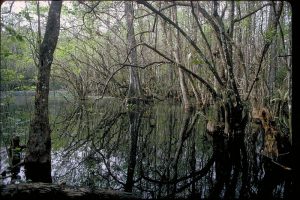Hardwood-Cypress Swamps, Unlikely Fire Hazards
By U.S. Forest Service Southern Research Station
7/7/2020

Hardwood-cypress swamp in Florida. Although the floor of this environment is typically covered in water, climate change is leading to drier conditions leading to a greater potential for fire. Photo by National Park Service, courtesy of Wikimedia Commons.
In parts of the southeastern U.S., one unlikely forest type has great potential for extreme fire behavior: hardwood-cypress swamps. These shallow wetlands can work with their more frequently burned neighbors, pine flatwoods, to wreak havoc by easily igniting and sustaining tremendous wildfires, thus depleting carbon storage in these forests.
Hardwood-cypress swamps and pine flatwoods are the focus of a recent study by Dan Krofcheck of the University of New Mexico, Albuquerque, USDA Forest Service researcher Louise Loudermilk, and colleagues. The study was published in the journal Ecosphere.
The group examined long-term management practices during extreme fire weather across these connected ecosystems. They asked, where and to what extent could fire management be used to most effectively suppress wildfires and continue storing carbon?
At the Osceola National Forest in Florida, where this study was conducted, the flatwoods and swamps are mixed together across its vast landscape, making fire management tricky. Pine flatwoods typically contain longleaf pines (Pinus palustris) and are managed with prescribed fire, applied every few years, and timber harvesting.
These forests are economically valuable for southeastern states through timber, hunting, recreation, and other Hardwood-cypress swamps are not actively managed and are typically flooded with water, making fire unlikely to occur. But when water levels are low or nonexistent, the dry floor can easily ignite and produce very intense fires. Maintaining forest carbon can lead to environmental stability, enabling the continued use of the forest’s resources. The wildfires within these environments can be mitigated by prescribed fire and other forms of land management, leading to questions that this article attempts to answer.
“Counterintuitively, the removal of fire is really the disturbance in pine flatwoods because when fire is removed, it will quickly change the pre-existing ecosystem to another ecosystem within a couple of decades,” says Loudermilk. “If we were to cease prescribed fire on this landscape, how would that change this endangered ecosystem and long-term carbon stocks given the inevitable onset of future wildfires?”
Read more here: https://www.srs.fs.usda.gov/compass/2020/07/07/hardwood-cypress-swamps-unlikely-fire-hazards/
Read the study in Ecosphere here: https://esajournals.onlinelibrary.wiley.com/doi/full/10.1002/ecs2.2631